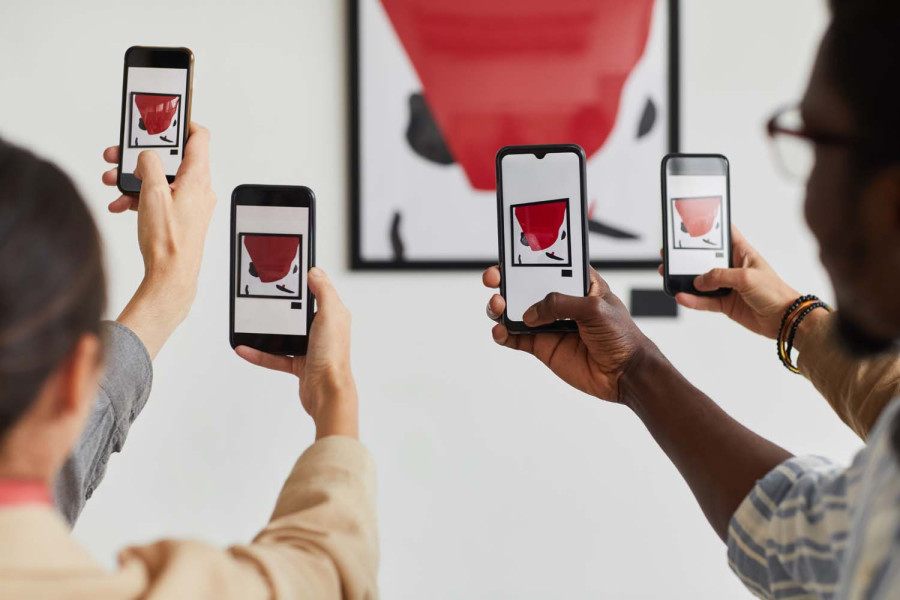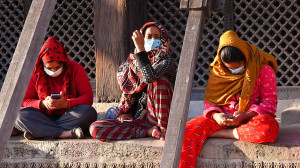Culture & Lifestyle
Art, aesthetics, and Instagram
More young people are visiting galleries—sometimes for the art, sometimes for the photos. Artists share how this is reshaping art spaces.
Skanda Swar
Walking into any art gallery, you’ll see some people focused on the artworks in front of them, while others are busy taking pictures. These galleries are no longer stuffy white cubes filled with silent adults deep in contemplation. Instead, they serve as potential locations for Instagram and Snapchat stories. But what’s the connection? For the many working artists out there, it’s not so black and white.
Three Nepali artists who spend time in galleries discuss this cultural phenomenon: Krisha Tamrakar (artist and co-director of Artudio), Bijaya Maharjan (multidisciplinary abstract artist and teaching faculty at Kathmandu University), and Sugat Shakya (cultural artist and teaching faculty at Srijana College of Fine Arts).
Everyone acknowledges that young people’s interest in the arts is increasing. “It has changed a lot,” Tamrakar observes. “Previously, most visitors were from the art community. However, in recent years, I’ve noticed a rise in younger visitors.”
While many come to galleries mainly to create content for social media, Tamrakar believes this is not entirely saddening.
“We have young people who genuinely come to appreciate the art—they spend time observing, ask thoughtful questions, and engage in conversations with artists. And then some come mainly for social media,” says Maharjan. “I notice that younger visitors often focus on taking photos and videos during opening receptions and exhibitions. I wish they would pay more attention to the art itself,” he adds.
The transformation of galleries into photo opportunities draws mixed reactions. Tamrakar says, “Any place that captures people’s interest can become a photo spot, and galleries are no exception.” She shares an experience when a young visitor who initially took selfies later returned to ask about the story behind a piece. However, Maharjan adds, “I’ve seen people treat the gallery like a backdrop, posing, changing outfits, using sculptures as props. Some spend two to three hours clicking pictures but barely glance at the work. It disrupts the mood of the space.”
Shakya’s perspective has evolved, “At first, I had mixed feelings about it. But the reality is, social media brings more people to see art. Many might come for the photos, but they still take the time to walk around and look at the pieces. In a way, social media has expanded the gallery experience.”
Social media’s influence on art experiences generates a variety of perspectives. Tamrakar believes it has both positive and negative effects.
For Maharjan, “Social media and reels have made promoting exhibitions easier. It brings in people who might not otherwise visit. But it also creates this performative culture of people coming just to say ‘I was here’ rather than actually being there with the art.”
Shakya believes, “Social media is helping art reach a much broader audience than it ever could before. I’ve noticed that when people post my art on social media, it encourages their friends to visit galleries as well. It’s a ripple effect. The more people see my work, the more they’re inspired to explore art themselves.”
Tamrakar recalls speaking to a friend who had a horrible experience. Once, a visitor put their coat on a sculpture on display and just took pictures, which disheartened him. After all, any sculpture is not a thing; it’s a creation full of meaning, purpose, labour, and emotion.

Yet, Shakya remains optimistic, “I’ve had experiences where people want to take photos instead of appreciating the art. But honestly, I accept this as something that will happen moving forward. I mean, it’s unfortunate, but at the same time, I understand it’s for them to share with their friends.”
Despite their differing views, all three artists share a common hope—that young visitors take away more than just photographs from their work.
“I want them to leave with something that resonates personally, whether it sparks new ideas, memories, or reflections about their own lives,” says Tamrakar.
Maharjan, whose abstract art invites open interpretation, adds, “I don’t like to tell people what my work means. I want them to find their own meaning and story in it. My work is rooted in culture and nature, and I hope it sparks something personal in them.”
The cultural element is key for Shakya, whose art draws heavily from tradition. “For me, art is about inspiring others and expressing oneself. I want young people to understand that art isn’t just about raw talent or a ‘gift’—it’s about hard work, dedication, and practice.”
Seeing young people as a key audience, all agree that education plays an important role.
“We need to involve youths in dynamic, interactive, and hands-on experiences—workshops, artist talks, open studios, and interactive exhibitions,” Maharjan says. “I have met young students who are curious, excited, and deeply thoughtful.”
He adds, “While the Instagram photo trend can be a bit bothersome, many genuinely interested young people take art home with them—in their sketchbooks, through email inquiries, and by bringing friends along on their next visit. This spark just needs the right space to flourish.”
This sentiment reflects the hope of Nepali artists to keep meaningful engagement with art alive in changing times, through the past and present, by documenting and sharing art experiences. All art forms, from traditional to contemporary and abstract to figurative, now find audiences, aided ironically by the same technology that once seemed to threaten deeper engagement. As galleries adapt to this new reality, the relationship between artist, artwork, and viewer is transformed. Still, it remains open and free, which has always been the essence of how art evolves.




 9.12°C Kathmandu
9.12°C Kathmandu













%20(1).jpg&w=300&height=200)

